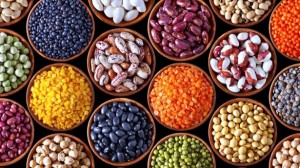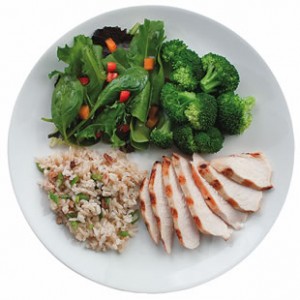Traditional thinking regarding weight loss has always centered around the all-mighty Calorie. After all, losing weight, being healthy and staying trim is all about calories in vs. calories out…right? Actually, not anymore!! If you were taught to think that way, you are probably more concerned with the numbers rather than the nutrients.
I am a strong believer in consuming quality vs. quantity in regards to the foods we eat. This means wholesome clean proteins, smart whole grains, plentiful variety of vegetables and seasonal/local fruits. Of course, I advise controlling your portions as well. Proper balance of foods will help you lose weight, build lean muscle, naturally detox your body, maintain good energy levels and even regulate your bowels and sleep patterns. However, the results of regular exercise are just not optimal without good healthy nutrition habits.
Nutrition Imbalance Leads to Overeating
One of the most common challenges that I hear from individuals is that it is hard for them to stay full (or satisfied) throughout the day, even after meals. For the vast majority of these individuals, they focus too much on either A. maintaining a low daily caloric intake, or B. removing main food groups. These actions can hamper your ability to create a balanced, nutrient-dense diet, causing you to overeat throughout the day, in hopes to sustain your energy levels. If this sounds anything like what you may be experiencing, I suggest taking a closer look at 1. the amount of protein you are consuming, 2. checking for veggies in each meal, and/or 3. trying to incorporate good quality carbohydrates and legumes into the diet. Both whole grains (ie: quinoa) and legumes (ie: lentils) are excellent sources of both carb and protein, helping to keep you satiated for longer periods of time. Making this slight change will help to increase your energy levels, while still keeping your calories in check.
 My Favorite Carbs & Legumes
My Favorite Carbs & Legumes
Healthy whole grain choices: quinoa, farro, brown rice, buckwheat, oats, bulgar, and whole rye.
Healthy legume choices: beans (black, lima,pinto), nuts (peanut, almond, walnut, pecan), peas (black-eyed and split) and lentils. It is best to opt for dry legumes rather than canned.
You can add both to soups and salads to enhance the nutritional value and to ensure you have more balance in your meal.
Healthy starchy vegetable choices: sweet potato, squash (yellow,acorn, butternut), zucchini, eggplant, pumpkin, and green peas.
The most nutritious meals come from fresh foods that are rich in vitamins and minerals, because they do not include all the processing that adds fat, sugar, sodium, added chemicals and empty calories (ie: many pre-packaged items).
*Quick tip you can implement for immediate change – add a fresh fruit and/or veggie protein smoothie to your diet a few times each week, either at breakfast or for a snack. This is a quick, fun and delicious way to add a strong serving of fruits, vegetables and protein to your diet. I promise you’ll feel a positive change from this subtle change. Need some inspiration? Check out my smoothie recipe guide for some great tasting ideas.

How to Balance Your Meals
Balance is key – that means balancing protein, fat and carbohydrates in each meal, but also ensuring there are enough vegetables in each meal to attain a good variety of vitamins and minerals.
*Quick Tip: Aim to consume 2- 3 servings of vegetables at both lunch and dinner. That will get you closer to the goal of having 4-5 servings of vegetables per day.
Home Cooked Meals Are More Fresh & Nutritious
Obviously, if you want to get the most health benefit from food, cooking at home is a very important part of the equation. This allows you to oversee every ingredient in the meal, plus you control where your food comes from, its freshness, and how it’s prepared. To make sure you stay on track, take a few minutes at the start of each week to plan out both lunches and dinners for yourself and/or family.
*Bonus – Along with eating healthier, you’ll be surprised how planning ahead actually starts to save you time and money.
Keep It Exciting – Try New Vegetables, Spices & Fruits
One of my favorite parts of healthy eating AND living in Florida is that there are SO many different varieties and options for fresh fruit and veggies throughout the year to choose from. I always find myself experimenting with new recipes and exploring with new vegetables in salads, all based on seasonal harvests. The growth of local farmers markets make it easier than ever to get quality produce at a good price, and that can help keep your financial health in balance, too! If you can carve out the time, I suggest going grocery shopping twice a week. I typically go to the local farmer’s market on Saturday to load up on fruits and veggies, then hit the grocery store once during the week to pick up little items that I need to complete recipes and meals. Need more meal inspiration? Check out some of my favorite recipes!

